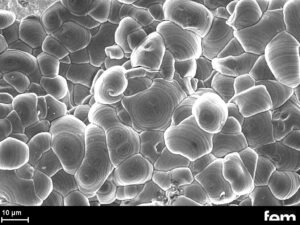The energy transition will only be successful if, in addition to the generation of electricity from renewable energy sources, the development of cost- and resource-efficient energy storage systems is also driven forward. Battery cells with the unique material pairing of calcium and sulphur are a promising candidate for the successor to the lithium-ion batteries currently in use: They reduce Germany's dependence on materials, minimise political, ecological and economic risks and offer enormous technological potential due to their low cost, good availability and high energy density.
Dieses Potential auszuschöpfen ist Ziel des FuE-Projekts “Calcium-Schwefel: Innovative Materialentwicklung für nachhaltigere Batterien”, kurz CaSino. Zu den Forschungspartnern zählen neben dem fem, das für die galvanische Herstellung der Calcium-Anoden zuständig ist, das KIT (elektrochemische Charakterisierung des Ca-Batterie-Elektrolyten), das DLR (Herstellung der Schwefel-Kathoden), das HIU (Modellierung der Prozesse in der Calcium-Schwefel-Vollzelle) und das NMI (Grenzflächenmorphologie und Strukturaufklärung). Die EuRA AG übernimmt die ökologische Bewertung der einzelnen Batteriekomponenten.
Together with the industrial partners Alantum, Varta, Custom Cells, Accurec and IoLiTec, a high-performance demonstrator of the calcium-sulphur battery cell is to be developed by 2025.

ACKNOWLEDGEMENT
The project is being funded by the Federal Ministry of Education and Research (BMBF) with around 3 million euros as part of the "Battery 2020 Transfer" programme.


